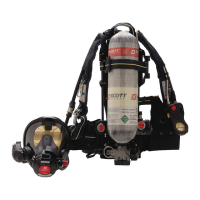12
REGULAR OPERATIONAL INSPECTION
The following procedure shall be used when you first receive the res-
pirator and for daily or periodic inspection of the respirator.
Respirators in regular use must be inspected at the start of each use
period and during cleaning after each use. Respirators maintained for
emergency use must be inspected at least monthly or as frequently
as required to assure the respirator will function properly when re-
quired. The US Labor Department (OSHA) requires, pursuant to 29
CFR 1910.134, at least monthly inspection of respirators maintained
for emergency use. NIOSH recommends an inspection for cylinder
pressure at least weekly.
The condition of storage at your location or the regulations which ap-
ply to your respiratory protection program may require more frequent
periodic inspections.
All respirators shall be inspected after each use. If any discrepancy
or malfunction is noted during the inspection, do not use the respira-
tor. Remove the respirator from service and tag it for repair by
authorized personnel.
Refer to the OPERATION AND MAINTENANCE INSTRUCTIONS for
the PASS DEVICE distress alarm installed on this respirator for addi-
tional inspection procedures. The required instructions are identified
by part number on the PASS DEVICE distress alarm label located on
the respirator backframe.
1. Visually inspect the complete respirator for worn or aging rubber
parts which exhibit cracking, splitting, or brittleness. Also inspect
for worn or frayed harness webbing and for other damaged com-
ponents.
2. Check the latest cylinder hydrostatic test date to ensure it is cur-
rent. All cylinders used with SCOTT AIR-PAK NxG
2
SCBA's must
be visually inspected regularly and hydrostatically tested by a li-
censed cylinder re-tester in accordance with the appropriate US
Department of Transportation (DOT) specification or the applicable
DOT exemption. For a complete listing of retest date requirements,
refer to the current revision of Safety Precautions for AIR-PAK Cyl-
inders, SCOTT P/N 89080-01, available on request from SCOTT
Health and Safety. Composite cylinders (those cylinders utilizing
fiber over wrap) must be tested in accordance with the DOT ex-
emption status up to the maximum life of fiber overwrapped cyl-
inders which, at the time of the publication of this instruction, is
15 years from the date of manufacture. The date of manufacture
marked on the cylinder is also the date of the first hydrostatic test.
It is the responsibility of your organized respiratory protection pro-
gram to arrange for visual inspection and hydrostatic testing of
cylinders by a licensed re-tester.
3. Visually inspect cylinder and valve assembly for physical damage
such as dents or gouges in metal or in composite wrapping. Cyl-
inders which show physical damage or exposure to high heat or
flame, such as paint turned brown or black, decals charred or
missing, pressure gauge lens melted or elastomeric bumper dis-
torted, and cylinders which show evidence of exposure to chemi-
cals such as discoloration, cracks in the cylinder or the composite
wrapping, peeling of the outer layers of the composite wrapping
and/or bulging of the cylinder wall, shall be removed from service
WARNING
THE INFORMATION BELOW IS MEANT TO SUPPLEMENT, NOT REPLACE, THE INSTRUCTIONS,
TRAINING, SUPERVISION, MAINTENANCE, AND OTHER ELEMENTS OF YOUR ORGANIZED RESPI-
RATORY PROTECTION PROGRAM. SEE WARNING ON THIRD PAGE OF THIS DOCUMENT. FAILURE
TO HEED ANY WARNINGS IN THIS INSTRUCTION MAY RESULT IN SERIOUS INJURY OR DEATH.
WARNING
FOLLOW THE REGULAR OPERATIONAL IN-
SPECTION PROCEDURE EXACTLY. IF THE
END OF SERVICE INDICATOR ALARMS DO
NOT ACTUATE AS DESCRIBED IN THIS IN-
STRUCTION, THE PURGE DOES NOT
ACTUATE AS DESCRIBED IN THIS IN-
STRUCTION OR ANY OTHER OPERATIONAL
MALFUNCTION IS NOTED, DO NOT USE
THE RESPIRATOR. REMOVE THE RESPIRA-
TOR FROM SERVICE AND TAG IT FOR
REPAIR BY AUTHORIZED PERSONNEL.
FAILURE TO PROPERLY IDENTIFY MAL-
FUNCTIONS MAY RESULT IN SERIOUS
INJURY OR DEATH.
WARNING
DAMAGED CYLINDERS MAY SUDDENLY
LEAK OR RUPTURE IF LEFT CHARGED
WITH COMPRESSED AIR. FAILURE TO IN-
SPECT FOR DAMAGE AND TO EMPTY THE
AIR FROM DAMAGED CYLINDERS MAY RE-
SULT IN SERIOUS INJURY OR DEATH.

